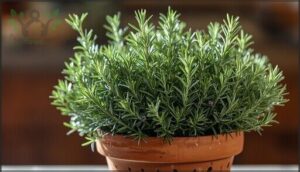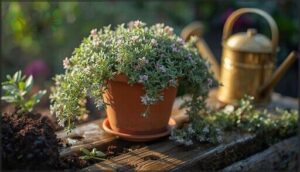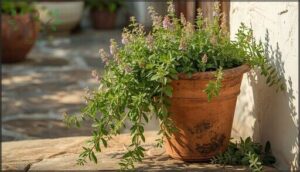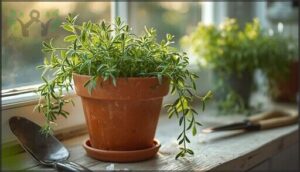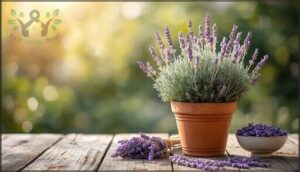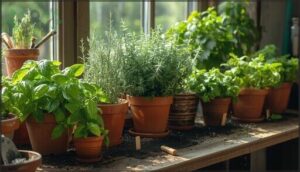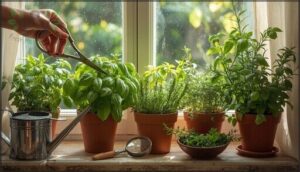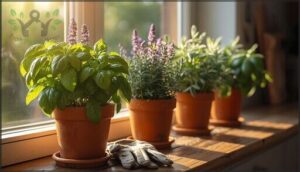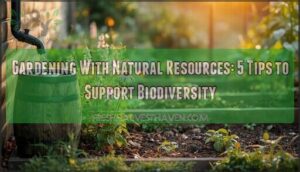This site is supported by our readers. We may earn a commission, at no cost to you, if you purchase through links.
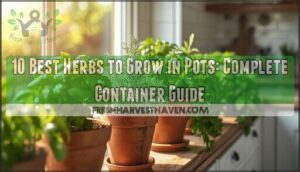
You don’t need a backyard to grow your own culinary herb garden—just a few pots, a sunny windowsill or patio, and the best herbs to grow in pots. Container gardening breaks all the traditional rules, giving you complete control over soil quality, drainage, and placement while keeping everything within arm’s reach of your kitchen.
Herbs like basil, rosemary, and mint actually thrive in containers, often performing better than their in-ground counterparts because you can tailor conditions to each plant’s preferences.
Whether you’re working with a cramped apartment balcony or simply want fresh oregano without the commitment of a full garden bed, growing herbs in pots delivers restaurant-quality flavors without the hassle.
Table Of Contents
- Key Takeaways
- Top Herbs to Grow in Pots
- Choosing The Right Herbs for Containers
- Essential Growing Conditions for Potted Herbs
- Care and Maintenance of Container Herbs
- Benefits of Growing Herbs in Pots
- Frequently Asked Questions (FAQs)
- Can you grow herbs in pots?
- What herbs grow well in containers?
- Can herbs grow in containers?
- What is the best herb to grow in a garden?
- Are herbs easy to grow?
- Which potting mix should I use for my herbs?
- What potting mix should I use for my herb garden?
- What are the best outdoor herb garden planters?
- What are the best herbs to plant in pots?
- What herbs are best grown in pots?
- Conclusion
Key Takeaways
- Container gardening gives you total control over soil quality, drainage, and placement while keeping culinary herbs within arm’s reach of your kitchen—no backyard required.
- Herbs like basil, mint, rosemary, and thyme actually thrive better in pots than in-ground because you can tailor growing conditions to each plant’s specific preferences for sun, water, and temperature.
- Proper container setup requires well-draining potting mix with perlite, pots sized to each herb’s root depth (6-16 inches depending on variety), and strategic watering based on whether you’re growing Mediterranean herbs or moisture-lovers.
- Regular harvesting and pruning—removing no more than a third of foliage at once—triggers explosive regrowth and can double your leaf yield while keeping plants compact and productive year-round.
Top Herbs to Grow in Pots
Growing herbs in pots doesn’t mean you’re stuck with boring or difficult plants. Some herbs practically thrive in containers, giving you fresh flavors without the fuss of a full garden bed.
Here are ten reliable herbs that’ll turn your pots into a productive kitchen garden.
Basil
Basil is your ticket to freedom in container gardening—those glossy leaves pack serious flavor for countless basil recipes while thriving in pots. You’ll want warm temps around 80-90°F and 6-8 hours of sunlight daily. Choose from various basil varieties like ‘Spicy Bush’ for compact spaces.
Watch for basil pests like aphids, and when basil harvesting time arrives, you’ll enjoy impressive yields of fresh, aromatic culinary herbs right from your indoor gardening setup. For ideal growth, consider using smart pot options to control soil moisture and temperature.
Mint
If you’re craving even more versatility in your container gardening setup, mint is your rebellious ally. This fast-spreading culinary herb thrives in 10-14 inch pots, reaching 7-13 inches tall while delivering 2.2 pounds per container. Mint varieties like peppermint and spearmint excel indoors with consistent moisture and good drainage.
You’ll harvest fresh leaves for mint tea, aromatic uses, and medicinal benefits—your herb garden just got seriously productive. For optimal growth, consider the mint growing conditions to guarantee a healthy and thriving plant.
Rosemary
Want that woodsy, intoxicating fragrance in your container garden? Rosemary’s your power move. This Mediterranean rebel thrives in 6-12 inch pots with killer drainage—terra cotta works best.
For rock-solid rosemary care, follow these pruning tips:
- Pinch soft stems at transplanting to encourage branching
- Harvest terminal shoots regularly before flowering (18-24 months)
- Prune to prevent woodiness and boost yield
You’ll get 1.7 pounds annually with proper container size and harvest timing.
Thyme
Thyme is your aromatic rebel—low-maintenance, drought-tough, and packed with thymol benefits that give it serious medicinal uses.
This culinary powerhouse thrives in 6-inch deep containers with killer drainage (terracotta is your friend).
Growing herbs in containers means you control everything: give it 6+ hours of sun, let soil dry between waterings, and harvest at 50% bloom for maximum aromatic oils.
Perfect for your container gardening herb garden.
Sage
Sage benefits your herb garden with those gorgeous leathery leaves and woodsy stature that screams “I own this container.” This herb cultivation champion needs 6-8 hours of sun, terracotta pots (12 inches wide minimum), and well-draining potting mix to prevent root rot.
Perfect for garden designs pairing with rosemary—both love lean soil and deliver serious fragrance uses in your container gardening setup.
Chives
Chives thrive like rebels in your container gardening setup—grassy clumps reaching 12 inches with edible blooms that’ll make your herb garden pop.
These hardy onion-family champions hit peak Chive Nutrition when you harvest timing’s right (snip leaves regularly for intense flavor).
Root Development stays strong in 8-12 inch pots with quality Potting Mix, tolerating 6-8 hours sun.
Their Leaf Structure naturally repels pests while attracting pollinators—talk about container plants working overtime.
Cilantro
Cilantro delivers bold Flavor Profiles you can’t get from dried versions—here’s why this container gardening superstar deserves space in your herb garden design.
Master these Growth Stages for maximum Leaf Harvest:
- Seed Germination hits in 7-10 days at 50-85°F
- First cutting arrives at 6 inches (30-45 days)
- Succession planting every two weeks keeps your stash loaded
- Deep pots (12+ inches) prevent taproot rebellion
Cilantro Nutrition packs serious punch—just follow these container plants gardening tips and you’ll harvest fresh leaves within weeks.
Oregano
Oregano Care turns your container gardening game into a Mediterranean flavor factory—this resilient herb thrives in 12-inch pots with minimal fuss.
You’ll harvest 85-120 grams per cycle once plants hit 4-6 inches, perfect for Oregano Recipes and Greek Cuisine adventures.
Keep soil pH between 6.5-7.0, water weekly, and prune before flowering to boost Medicinal Oregano potency.
These Oregano Varieties dominate herb garden design with zero drama.
Tarragon
Tarragon transforms your container gardening into a French cuisine powerhouse—this perennial delivers licorice-kissed leaves in 8-12 inch terracotta pots with proper drainage.
For ideal tarragon care in your herb garden design:
- Potting Mix: Blend organic matter with perlite for 6.5-7.5 pH
- Watering: Young plants need moisture every other day; mature ones tolerate dryness
- Light: Full sun works, partial shade prevents wilting in scorching climates
- Herb Nutrition: Rich in manganese and iron for aromatic uses
French tarragon dominates culinary herb uses—propagate through cuttings since seeds fail spectacularly.
Lavender
Lavender turns your container gardening into a fragrant retreat. This bushy perennial thrives in 12–16 inch pots with well-drained potting mix (pH 6.5–7.5) and delivers aromatic uses beyond the kitchen.
You’ll harvest up to 1.7 pounds per pot yearly for lavender oil, drying methods, and fragrance benefits.
Perfect for indoor and outdoor gardening, it’s herb garden maintenance made simple for gardening for beginners.
Choosing The Right Herbs for Containers
Not all herbs adapt equally to container life, so choosing the right ones from the start saves you time and frustration. You’ll want to think about how each herb grows, what conditions it demands, and how you actually plan to use it in your kitchen or medicine cabinet.
Let’s break down the key factors that’ll help you pick winners for your pots.
Growth Habits and Space Needs
Your container garden success starts with matching pot size to growth patterns. Basil thrives in 6–8 inch pots, while mint demands 10–12 inches to contain its rebellious runners. Rosemary needs room for its woody frame—go 8 inches minimum. Thyme spreads wide, reaching 20 inches across, so plan for lateral expansion.
Root depth and soil volume directly impact your harvest, making proper plant spacing non-negotiable for potted herbs.
Sunlight and Climate Preferences
Most culinary herbs demand 6 to 8 hours of sunlight daily—basil, rosemary, and oregano won’t compromise. Shade-tolerant rebels like mint and cilantro survive on 4 to 6 hours, perfect for dappled spots.
Temperature tolerance varies wildly: basil stalls below 60°F, while chives laugh off freezing soil temps. Humidity levels matter too—Mediterranean types want dry air under 50%, but mint craves moisture above 60% to prevent leaf-tip browning.
Culinary and Medicinal Uses
Beyond sun and soil, you need herbs that actually earn their keep. Basil dominates 80% of Mediterranean recipes for flavor enhancement, while mint addresses digestive comfort with a 20% improvement in surveys.
Rosemary and sage deliver phytochemical benefits—polyphenols that cut inflammation markers by 14–23%. Lavender drops anxiety scores 32% through aromatic therapy.
Choose culinary and medicinal herbs that work double duty.
Essential Growing Conditions for Potted Herbs
You’ve picked your herbs—now let’s talk about what they actually need to thrive in containers. Getting the basics right from the start means healthier plants and bigger harvests without a ton of fuss.
Here’s what you need to know about soil, water, and choosing the right pots.
Soil and Drainage Requirements
Think of soil quality as your herbs’ life support system—get it wrong and you’re stuck with limp, flavorless plants. You need potting mix with perlite or vermiculite, not garden dirt, to nail drainage systems and root health.
- Sandy loam with 50–70% sand content creates the perfect escape route for excess water
- Pots with multiple drainage holes slash root rot risk by 60%
- pH between 6.0–7.0 unlocks nutrient uptake your herbs desperately need
- Fresh potting mix every 1–2 years can double your harvest
Quality soil management and proper water retention turn container gardening from frustrating to foolproof.
Watering and Fertilization Tips
Most container herbs die from watering mistakes, not neglect. Mediterranean varieties like rosemary demand water every 7–14 days once the soil dries completely, while basil craves moisture every 3–4 days. Check soil moisture with your finger—dry at a 1-inch depth signals watering needs for soft-leafed herbs.
| Herb Type | Water Frequency |
|---|---|
| Rosemary, Thyme | Every 7–14 days |
| Basil, Cilantro | Every 3–4 days |
| High Heat (85°F+) | Daily checks needed |
Feed with liquid fertilizer every 2–4 weeks during the growing season. Nitrogen at 100–200 mg·L fosters vigorous growth in basil and sage without nutrient waste. Water before fertilizing—never apply to bone-dry soil or you’ll torch roots.
Deep soaking beats daily spritzing for building drought-tough plants. Wind-exposed containers lose moisture 50% faster, so group pots together or relocate to sheltered spots. Drip irrigation methods slash water use by 40% compared to overhead watering while delivering nutrients exactly where roots need them. Skip the guesswork—moisture meters reading below 25% trigger watering time for most culinary herbs, keeping your plant care dialed in.
Pot Size and Material Considerations
Your herbs need room to breathe—give each plant at least one gallon of soil volume for solid root depth. A 12-inch pot holds about 3.5 gallons, perfect for four herbs in container gardening setups.
Plastic planters retain moisture better than clay, cutting watering chores while your herb garden design stays flexible. Multiple drainage systems prevent waterlogging, keeping your container gardens thriving even in limited space.
Care and Maintenance of Container Herbs
Once your herbs are settled into their pots, keeping them healthy and productive doesn’t require a green thumb—just a few smart habits. The right approach to pruning, pest control, and seasonal adjustments will keep your container herbs thriving year-round.
Here’s what you need to know to maintain a flourishing potted herb garden.
Pruning and Harvesting Techniques
Grab your sharp scissors or pruning shears—clean cuts matter. Snip just above a leaf joint when your herbs have at least three full sets of leaves, removing no more than a third of the foliage at once. This stem cutting technique triggers explosive regrowth and can double your leaf yield.
Harvest every 1-2 weeks for basil and mint, catching them in early morning for peak flavor.
Pest and Disease Prevention
Your container herbs can fall victim to pests and disease faster than you think. Regular pest monitoring—checking sticky traps weekly and inspecting leaves—catches problems early.
Deploy biological controls like predatory insects to slash aphid invasions by 80%. Organic solutions such as neem oil deliver 65-80% reduction when applied consistently.
Sanitation practices matter: remove debris after every harvest, sanitize pots between plantings, and maintain strict disease management protocols to keep your herb garden maintenance manageable.
Overwintering and Seasonal Care
When frost protection becomes your top priority, you’ll need a solid strategy. Hardy perennials like mint and chives survive outdoors in 16″-20″ containers, but tender rosemary demands shelter before temperatures hit 40°F.
- Winter pruning: Trim stems to 4-6 inches after the first hard frost for root hardening
- Soil insulation: Group pots and mulch heavily to prevent freeze damage
- Cold frame management: Maintain 45°F-60°F in unheated spaces for tender herbs
- Watering adjustments: Check soil every 2-4 weeks—dormant plants need 60% less water
- Indoor transitions: Move containers inside before frost for 80% better survival rates
Your herb plant care approach should shift dramatically as seasons change—container gardening tips that work in summer can kill plants in winter.
Benefits of Growing Herbs in Pots
Growing herbs in pots isn’t just a workaround for small spaces—it’s actually a smarter way to garden on your own terms. You’ll get total control over your herbs’ environment, plus the freedom to move them wherever they work best for your lifestyle.
Container herb gardening isn’t a compromise—it’s superior control and flexibility on your terms
Let’s break down the real advantages that make container herb gardening worth your time.
Space-Saving and Flexibility
You’re not chained to a sprawling backyard to grow your own food. Vertical gardening and container mobility let you squeeze multiple herb planters into less than 2 square feet—perfect for urban gardening on balconies or fire escapes.
Small space herb gardening means you can shuffle pots around for ideal sun, weather-proof your setup, and keep aggressive growers like mint from hijacking your entire space. Container gardens deliver serious space efficiency without compromise.
Easy Access for Cooking
Beyond saving space, your kitchen herb garden puts fresh picks right where the action happens. Studies show home cooks reach for potted culinary herbs 54% more often than outdoor plants—you’ll slash time by 7 minutes per meal and cut store-bought waste by 62%.
Here’s what cooking convenience looks like:
- Snip what you need while chopping onions
- Skip wilted grocery store bundles completely
- Experiment with 44% more herb varieties in recipes
- Use fresh herbs at least three times weekly
Indoor herb gardening transforms meal prep from chore to creative flow—your container gardening setup becomes the supreme cooking hack.
Control Over Growing Conditions
You’re not chained to weather patterns or wonky soil when you grow herbs in containers. Container gardening hands you the reins completely.
Water control becomes precise—delivering the perfect 0.5 gallons per hour your basil demands. Move pots around for ideal light management as seasons shift.
Adjust soil temperature by swapping dark containers for light ones, cutting heat stress by 15°C.
Decorative and Aromatic Value
Potted herbs pull double duty—transforming your space while tickling your senses. Roman chamomile, lavender, and rosemary pack serious aromatic punch, freshening rooms naturally. These fragrant plants don’t just smell amazing—they look stunning too.
- Evergreen rosemary and silver thyme grow 24 inches tall, providing year-round visual interest in any pot design
- Lavender’s striking flower heads work beautifully in herb arrangements, fresh or dried
- Sage and mint deliver lush foliage that makes container gardening ideas come alive
- Ornamental varieties complement your décor while offering fragrant and edible plants for cooking
Scented gardens have never been easier.
Frequently Asked Questions (FAQs)
Can you grow herbs in pots?
Absolutely—over 90% of culinary herbs thrive in containers when you provide proper drainage and space.
Container gardening gives you total control, making potted herbs perfect for small space gardening and indoor growing tips success.
What herbs grow well in containers?
Looking for easy wins in your container gardens? Basil, mint, rosemary, and thyme top the list—they adapt beautifully to pots with decent drainage and 6–8 hours of sunlight daily.
Can herbs grow in containers?
Yes, herbs thrive in containers—over 60% of home herb gardens now use pots.
Container gardening offers space efficiency, controlled growing conditions, and excellent root growth when you use proper potting mix with good drainage.
What is the best herb to grow in a garden?
Basil tops the list—grown by over 70% of home gardeners—because it thrives in full sun, yields generously, and fits nearly any climate or garden planning strategy.
Rosemary, thyme, and mint follow closely behind.
Are herbs easy to grow?
Most herbs are incredibly forgiving—kind of like that friend who never holds grudges. Chives, mint, and thyme boast survival rates above 90%, making them ideal for beginners keen to master basic container gardening.
Which potting mix should I use for my herbs?
Choose container gardening potting mix composition with perlite or organic blends for drainage materials and soil structure.
Compost-enriched options support herb plant care, while fertilizer options maintain plant care and soil quality in container gardens year-round.
What potting mix should I use for my herb garden?
Don’t throw money down the drain with the wrong mix. You’ll want a 60-75% peat moss base blended with perlite for drainage, keeping that pH sweet spot between 0-0 for thriving container gardens.
What are the best outdoor herb garden planters?
Look for elevated designs like Vegtrug or Panacea galvanized planters with built-in drainage. Self-watering models like Vegepod keep herbs thriving longer, while vertical gardens optimize compact spaces—perfect for outdoor container gardening freedom.
What are the best herbs to plant in pots?
Start with compact culinary favorites like basil, chives, and cilantro—they’re beginner-friendly and adapt beautifully to container gardening.
Add rosemary, thyme, and mint for year-round harvests that’ll transform your cooking game completely.
What herbs are best grown in pots?
Basil, mint, rosemary, thyme, and chives dominate container gardening because they adapt brilliantly to restricted root space.
These culinary herbs deliver impressive foliage yields while thriving in well-draining herb potting mix with proper watering schedules.
Conclusion
Funny how the best herbs to grow in pots don’t actually need a “real” garden to outperform everything else. Your windowsill basil will shame most backyard plots, and your countertop rosemary won’t care that it’s missing dirt beneath its roots.
You’ve just discovered that freedom from traditional gardening rules gives you better flavor, zero weeds, and total control. So grab those containers and grow something worth eating—no yard required.
- https://learn.eartheasy.com/articles/the-12-best-herbs-for-planter-boxes-and-containers/
- https://extension.psu.edu/growing-herbs-indoors/
- https://www.rhs.org.uk/herbs/containers
- https://digitalcommons.usu.edu/cgi/viewcontent.cgi?article=1742&context=extension_histall
- https://www.producegrower.com/article/controlling-containerized-herb-growth/



